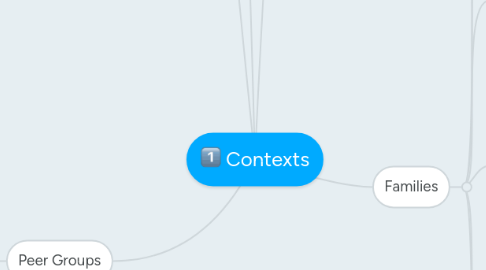
1. Origin of High school education
1.1. child labor laws established
1.2. industrailization
1.3. high schools was for the affluent only
1.3.1. liberal arts, only for the elite
1.4. the comprehensive high school was born.
2. Peer Groups
2.1. age grading-grouping peers together based on age
2.1.1. youth population growth
2.1.2. problem or necessity?
2.1.2.1. some people believe that youth culture is troublesome
2.2. spend more time with their peers than with adults
2.2.1. want more independence
2.3. cliques and crowds
2.3.1. clique members, isolates, or liaisons
2.3.2. romance changes peer groups, as they begin to be interested in other sex, diverge from same sex peer groups
2.4. changes in crowds, nerds, preps, jocks, etc.
2.5. ethnicity and crowd membership
2.5.1. peer groups are divided among cultures, then into jocks etc.
2.6. segregate into different ages
2.6.1. sex appropriate behavior is encouraged, ridiculous!
2.6.1.1. what is acceptable for boys and girls in peer groups
2.7. sex segregation into different peer groups
2.8. ethnicity segregation
2.8.1. most peers have friends in their same ethnicity than in the same socioeconomic group.
2.9. Common interests among friends
2.9.1. orientation twoards school
2.9.1.1. sports, studying, etc. hang out with peers that have same school interests
2.9.2. gangs, antisocial groups
2.9.2.1. not always delinquent, not always criminal
2.9.2.2. antisocials have friends, share same interests in antisocial behavior
2.9.2.3. some prone to violence and criminal activity.
2.9.3. teen culture
2.9.3.1. music, dress etc.
2.9.4. having strong and positive family and parents relationships often has positive impact on groups choices.
2.10. stability of adolescent friendships
2.10.1. most relationships are between kids that have same attitudes. Some leave and are replaced with other kids that are similar.
2.10.2. most "best" friendships remain over the course of one year, and remain friends.
2.10.3. boys friendships are more stable than girls.
2.11. popularity
2.11.1. sociometric
2.11.1.1. how much someone is liked
2.11.2. percieved
2.11.2.1. how well known someone is
2.11.3. being mean can mean being more popular
2.12. agression
2.12.1. some students exhibit aggression and it can make them more popular.
2.12.2. "mean girls"
2.12.3. relational aggression-deliberatiely trying to hurt someone with gossip, manipulation of friendships.
2.12.4. can lead to rejection, depression in some kids.
2.13. Victimization and Harassment
2.13.1. victims and bullies
2.13.2. victimizing a withdrawn classmate
2.13.3. not a common relationship
2.13.4. 1/3 of students have been bullied at one time in the last year.
2.13.5. cyberbullying
2.13.5.1. occurs over internet or cell phones
2.13.5.2. far less common than most people think
2.13.6. victims report a wide rands of adjustment problems
2.14. problematic relationships with peers can lead to an array of problems, more likely to drop out or do poorly academically.
3. Schools
3.1. social organization of schools
3.1.1. bigger is better?
3.1.2. strengths of small schools
3.1.3. class sizes
3.1.3.1. overcrowding, too many student to teacher ratio
3.1.4. tracking, not good!
3.1.4.1. all schools to this to some degree
3.2. desegregation of schools happened
3.2.1. effects of desegregation
3.2.2. previously segregated schools by race!
3.3. different school offered
3.3.1. charter or magnet schools
3.3.2. public schools or private schools
3.3.3. religious or independent
3.4. classroom climate
3.4.1. teacher expectaions vs student performance
3.4.1.1. strong correlation
3.4.1.1.1. negative or positive!
3.4.2. student engagement
3.4.2.1. how committed students are to learning
3.4.3. boring classes, boring students
3.4.3.1. better teachers, better students are performing
3.4.4. college bound students
4. No Child Left Behind
4.1. president bush enacted NCLB
4.2. required schools to text and reports scores to public
4.3. all students are to receive adequate schooling regardless of economic place
4.4. social promotion of students if they are not ready and not prepared to enter workforce or college
4.5. resistence, from teachers, school, and parents about emphasizing testing in math and literature.
5. Families
5.1. conflict between parents and teens
5.1.1. usually fight about curfews, leisure time activities, clothing
5.1.2. do not usually fight about large issues
5.1.3. usually gap is in dress, core values, etc.
5.1.4. rebel in small issues, not usually to just rebel
5.2. midlife crisis in parents
5.2.1. parents see their kids as the young ones now, and they feel old
5.2.2. leading to midlife crisis
5.2.3. adolescence is difficult for parenting, not just for teens
5.3. mothers are often the comforters
5.3.1. dads are seen as more distant
5.3.2. fight more with mothers
5.3.3. 4 styles of parenting
5.3.3.1. authoratative
5.3.3.2. authoritarian
5.3.3.3. indulgent
5.3.3.4. indifferent
5.3.4. relationships with siblings
5.3.4.1. often fight during when younger
5.3.4.2. seen as more friendships
5.4. genetic and environmental influences
5.4.1. shared and non shared
5.4.1.1. who they live with
5.4.2. sibling rivalry
5.5. family in changing society
5.5.1. divorce
5.5.1.1. more than 40% of homes are divorced
5.5.1.2. effects are long lasting
5.5.1.3. genetic influences
5.5.1.4. sleeper effects
5.5.1.5. what children are told about other parents
5.5.2. remarriage
5.5.2.1. can be difficult to adjust
5.5.2.2. many remarriages end in a divorce
5.5.3. single parent households
5.5.4. poverty
5.5.4.1. economic issues, more children in poverty, especially from single parents homes
5.5.5. homosexual parents
5.5.5.1. no evidence that children with gay or lesbian parents are any different than with hetero parents
5.5.6. adopted children
5.5.6.1. not much of difference between adopted and non adopted children
5.5.6.2. can have higher instances of delinquency etc.
5.5.7. foster care
5.5.7.1. 175,000 children in foster care currently
5.5.7.2. enter into foster care as adolescents, 1/3
5.5.7.3. more at risk for emotional problems
5.6. quality of relationships at home influence
5.6.1. most of adolescents adjustment if the quality of home life.
